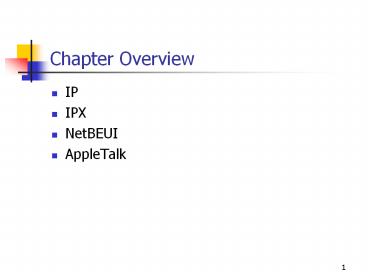Chapter Overview - PowerPoint PPT Presentation
Title:
Chapter Overview
Description:
... Address field in the IP header always identifies the packet's final destination. ... Fragments are not reassembled until they reach their final destination. ... – PowerPoint PPT presentation
Number of Views:17
Avg rating:3.0/5.0
Title: Chapter Overview
1
Chapter Overview
- IP
- IPX
- NetBEUI
- AppleTalk
2
Network Layer Protocols
- Responsible for end-to-end communications on an
internetwork - Contrast with data-link layer protocols, which
provide communications on the same local area
network (LAN)
3
IP Encapsulation
4
IP Functions
- Encapsulation
- Addressing
- Routing
- Fragmentation
- Protocol identification
5
The IP Datagram Format
6
IP Addresses
- Internet Protocol (IP) is the only network layer
protocol with its own addressing system. - IP addresses are 32 bits long.
- IP addresses have two parts a network identifier
and a host identifier. - IP addresses are assigned to network interface
adapters, not to computers. - The Source IP Address field in the IP header
always identifies the computer that generated the
packet. - The Destination IP Address field in the IP header
always identifies the packets final destination.
7
End Systems and Intermediate Systems
8
Fragmentation
- Routers connect networks that support
different-sized packets. - The largest packet size supported by a network is
called its maximum transmission unit (MTU). - When a packet is too large to be forwarded to a
particular network, the router splits it into
fragments. - Each fragment is encapsulated with a header and
is transmitted as a separate packet. - Fragments are not reassembled until they reach
their final destination. - Fragments can themselves be fragmented.
9
Fragmentation (Cont.)
10
Protocol Field Values
0 IP
1 ICMP
3 Gateway-to-Gateway Protocol (GGP)
6 TCP
8 Exterior Gateway Protocol (EGP)
17 UDP
11
The IPX Standard
- Developed by Novell for use with NetWare
- Proprietary never published as a public standard
- Reverse engineered by Microsoft to create NWLink
12
IPX Functions
- Routing
- Addressing
- Protocol identification
13
The IPX Header Format
14
IPX Addressing
- Internet Packet Exchange (IPX) uses
- Separate node and network addresses
- Network interface adapter hardware addresses for
node addresses - Network addresses
- Are assigned by administrators
- Do not need to be registered
15
NetBEUI Characteristics
- Original Microsoft Windows default networking
protocol - Designed for small local area networks (LANs)
- Does not support Internet communications
- Does not need configuration
- Can be used to troubleshoot Transmission Control
Protocol/Internet Protocol (TCP/IP) configuration
protocols
16
NetBIOS Names
- Assigned to computers during Windows installation
- Sixteen characters long the sixteenth character
is a resource identifier - Can identify computers, domain controllers,
users, groups, and other resources - Have no network identifier (which is why NetBEUI
is nonroutable)
17
The NBF Protocol Format
18
Protocols Using NBF
- Name Management Protocol (NMP)
- Session Management Protocol (SMP)
- User Datagram Protocol (UDP)
- Diagnostic and Monitoring Protocol (DMP)
19
AppleTalk Data-Link Layer Options
- LocalTalk
- EtherTalk
- Fast EtherTalk
- TokenTalk
- FDDITalk
20
Datagram Delivery Protocol
- AppleTalks network layer protocol
- Provides packet addressing, routing, and protocol
identification - Has short-format and long-format packet headers
21
AppleTalk Addressing
- AppleTalk computers have a unique 8-bit node ID
that is self-assigned. - AppleTalk networks can have no more than 254
nodes. - AppleTalk uses 16-bit network numbers for
routing. - Computers obtain network numbers using the Zone
Information Protocol (ZIP). - Computer processes are identified by 8-bit socket
numbers.
22
AppleTalk Addressing (Cont.)
- Network numbers, node IDs, and socket numbers are
expressed as three decimal numbers, separated by
periods. - AppleTalk computers resolve node IDs into
hardware addresses, using the AppleTalk Address
Resolution Protocol (AARP). - AppleTalk computers also have friendly names and
groups of computers called zones.
23
Chapter Summary
- Network layer protocols are responsible for
end-to-end communications across the network. - IP is a connectionless protocol that encapsulates
transport layer data into datagrams. - IPX is a proprietary standard that performs
routing, addressing, and protocol identification. - NetBIOS Extended User Interface (NetBEUI) is used
by small Windows networks for LAN networking. - AppleTalk provides basic networking to small
networks.































